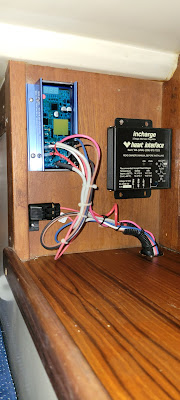Orion DC-DC 12/12 18Amp TR Smart Charger Installation
Here's a link to why I'm doing this, basically it's to charge our Start Battery.
| Overview of the Orion Charger |
The Install was pretty easy.
Mount the Orion on the bulkhead below the other Victron equipment
Drill a hole through the bulkhead for the wires from the Orion to the Start Battery
Make up an empty Fused wire for the +ve connection from the Orion to the Multiplus.
Make up the wire for the -ve connection from the Orion to the Multiplus
Inset the fuse and power up the Orion - Update the firmware and the program for AGM battery ( see note below ) then power it down ( remove the fuse. )
Makeup the Fused wire from the Orion output to the Start Battery +ve
Makeup the wire from the Orion output to the Start battery -ve.
Insert the Orion input fuse
Insert the fuse at the Start Battery
Monitor the Start Battery status on the VictronConnect App on my phone.
Notes:
- At present there is no way to view the Orion Smart DC/DC charger on the VRM. I did read where someone had installed a Smart Shunt into the -ve connection from the Start Battery to the Orion but have not figured out if it's worth it yet. There's also some issue as the Orion is an "Isolated" charger, but the Start Battery and the House Battery share a common ground. More research to figure that one out.
- The Preset Charging Profiles in the Orion do not appear to support AGM batteries except for Tubular batteries. However, Selecting any of the AGM type profiles and editing the profile switches to a User Defined Profile. We looked up the Duracell AGM SL178 charging profile and updated the charger's profile with those numbers.
- Although we cannot see the status of the Orion in the VRM we can see it via Bluetooth at the boat. Also, we can see this:
We did a test start of the engine today, 1st time using the new battery. What a delight, it virtually jumped into action. After 90 seconds the Tacho showed that the Alternator was running. We were on shore power and the VictronConnect app showed that the charger was in Bulk mode, a short while later, it dropped into Absorption and finally into Float. Looks like I made the right decision.
See you on the water - We'll be taking the boat out tomorrow for the weekend.




